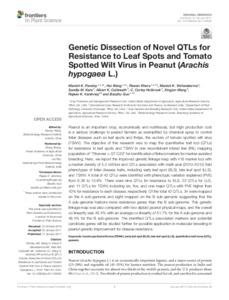Genetic Dissection of Novel QTLs for Resistance to Leaf Spots and Tomato Spotted Wilt Virus in Peanut (Arachis hypogaea L.)
Abstract
Peanut is an important crop, economically and nutritiously, but high production cost is a serious challenge to peanut farmers as exemplified by chemical spray to control foliar diseases such as leaf spots and thrips, the vectors of tomato spotted wilt virus (TSWV). The objective of this research was to map the quantitative trait loci (QTLs) for resistance to leaf spots and TSWV in one recombinant inbred line (RIL) mapping population of “Tifrunner × GT-C20” for identification of linked markers for marker-assisted breeding. Here, we report the improved genetic linkage map with 418 marker loci with a marker density of 5.3 cM/loci and QTLs associated with multi-year (2010–2013) field phenotypes of foliar disease traits, including early leaf spot (ELS), late leaf spot (LLS), and TSWV. A total of 42 QTLs were identified with phenotypic variation explained (PVE) from 6.36 to 15.6%. There were nine QTLs for resistance to ELS, 22 QTLs for LLS, and 11 QTLs for TSWV, including six, five, and one major QTLs with PVE higher than 10% for resistance to each disease, respectively. Of the total 42 QTLs, 34 were mapped on the A sub-genome and eight mapped on the B sub-genome suggesting that the A sub-genome harbors more resistance genes than the B sub-genome. This genetic linkage map was also compared with two diploid peanut physical maps, and the overall co-linearity was 48.4% with an average co-linearity of 51.7% for the A sub-genome and 46.4% for the B sub-genome. The identified QTLs associated markers and potential candidate genes will be studied further for possible application in molecular breeding in peanut genetic improvement for disease resistance

